The Paradox of Chenin: Ten of Lower Loire’s Top Young Producers Showcase The Multifaceted Faces of The Grape in Three Distinct Regions (10-Bottle Sampler $399)
Join Us for Saturday Sips: The Paradox of Chenin
Come as you are; come any time that’s convenient for you during our business hours to sample selection from this week’s selections. Our staff will be on hand to discuss nuances of the wines, the terroirs reflected, and the producers.
If ever a grape variety deserves the Chameleon Award, it’s Chenin in the Loire. Its sheer versatility in the Garden of France may account for the fact that American palates have tended to champion somewhat one-dimensional (if beautifully structured) Sauvignon Blancs from Pouilly-Fumé and Sancerre, and laud the briny, if simple Muscadet as a go-to shellfish accompaniment, while most would be hard pressed to name a Chenin from the Loire beyond Vouvray.
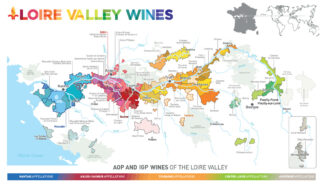
And yet, with relative ease, Chenin makes outstanding wines that are dry, sweet, sparkling and every nuanced shade between. It is not only the most dynamic variety grown in the Val de Loire, it can rival the most age-worthy white wines made anywhere. In Savennières, for example, the grape’s somewhat neutral natural taste soaks up terroir, making it the apogee of cellar-worthy Chenin. Likewise, an ability to mature is the hallmark of Vouvray from Touraine, where patience may reap rewards after twenty years or more in the development of baked apple subtleties while the acidity remains crisp with youth.
And the wine moves to the sweet side, pinning down the acids is one of the consummations that Chenin strives for; here, a cooler climate is a boon, and the narrow valleys produce cool mists, especially in autumn, promoting botrytis.
The third Chenin style, sparkling, is centered around Saumur, where with Champagne-like cellars carved out of the friable rock cliffs. In Saumur, though, sparkling wine producers often blend Chenin with Chardonnay and Cabernet Franc and the more recently created appellation, Crémant de Loire, which can be made anywhere along the Loire Valley, is more likely to be made from Chardonnay and Pinot Noir as it is in Champagne. But in Touraine, in Vouvray and Montlouis-sur-Loire, Chenin returns to its diva role. Here, sparkling wine is made using grapes from vines used for still wines, only picked earlier to instill the high acid content that is a hallmark of balance.
This week’s package showcases the three multifaceted faces of Chenin as displayed by some of the region’s top young producers from each of the primary appellations.
Written In Stone
The story of terroir is first carved into stone, and in the Loire—as in Champagne and Chablis—its foundation is a peculiar geological phenomenon known as the Paris Basin. Surrounded by high-ground massifs, the basin formed following the withdrawal of an inland sea that covered much of central France 70 million years ago. Today, alternating beds of limestone, sand and clay dip toward the city of Paris, their outcrops forming concentric patterns and filling valleys with rocks from the Paleogene and Neogene periods.
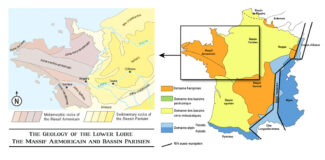
In general, Loire’s soil can be defined as consisting of four types—Kimmeridgian, Portlandian, Oxfordian and Albian. In Anjou, the subsoil is mainly slate and carboniferous schists admixed with volcanic rock, all originating from the Massif Armoricain. Between Angers and Saumur, there is a transition from older bedrock to the west to the sedimentary basin to the east. In Touraine, the subsoil is made up of tuffeau limestone, sand and siliceous clay.
Each has a specific role to play in the many mineral notes that show up in these wines.
Anjou-Saumur
This hyphenated region pays homage to the similar terroirs of Anjou and its much smaller neighbor Saumur. Chenin the common thread. Anjou, formerly known for its aromatic and full-bodied sweet wines (often using botrytized grapes), is expanding its reputation into rich, dry wines, notably in Savennières. Saumur’s fame has traditionally been derived from its Chenin-based sparkling wine drawn from chalky soils similar to Champagne.
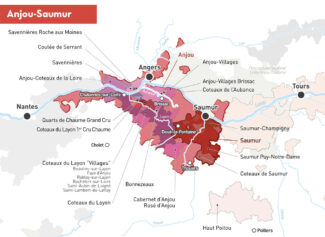
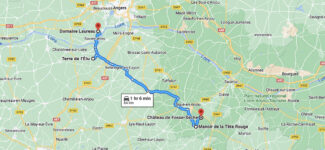
Savennières A.O.P
What a difference a set of regulations make! Once known almost exclusively for sweet wines (often from late-harvested grapes in the typical Anjou style), Savennières has forged for itself a spot among the most respected French appellations for dry, cellar-eager white wines. Chenin is the only permitted grape, making Savennières the lone dry white appellation in Anjou’s sea of sweet. This status was originally sought in order to compete with the Sauvignon Blancs of Sancerre—crisp, austere and often steely, yet paradoxically, both full-bodied and light. Although standard Savennières is now officially dry, Demi-sec and Moelleux and Doux versions are also allowed, with rules to indicate precisely how wines with higher levels of residual sugar must be labeled.
Savennières is river country, and the Loire retains the supreme influence on the climate. ‘La douceur angevine’ is a local term used to describe the smooth and subtle nature of the wines; It translates to ‘The sweetness of Anjou’ and may also refer to that easy riparian lifestyle that is characteristic of Savennières. Perched on a rocky plateau, the town overhangs the Loire River and several clefts form castings that which benefit from an ideal south/southwest exposure. Soils are not deep, and the shale gives a pronounced minerality to the wine.
Domaine Damien Laureau
The respected magazine ‘La Revue de Vin de France’ has singled out Damien Laureau as ‘the future of Savennières’, both for his back-to-basics approach and for his astonishingly wonderful results. Working out of a small shed, Laureau is indeed a forward-looking winemaker: Fruit extracts and other non-synthetic treatments are used on the vines in place of harsh chemicals, and has begun to experiment with harvesting just when the grapes turn yellow instead of the ‘green stage’ that has been viewed as a Savennières tradition, leaving wines with a potential alcohol volume of 12% or less. Equally, Laureau dodges high levels of botrytis to keep his wines lively with acids.

Damien Laureau, Domaine Laureau
“The old methods resulted in backward, stern, and fairly austere wines that took at least a decade to reach a point where they began to show their charms,” he explains. “Trends have begun to change: Better farming, in many cases biodynamic or organic, have reduced yields and we are now hand-harvesting golden grapes and back away from reduction by using neutral wood barrels for aging and less sulfur during winemaking. These steps combine to produce more approachable wines that do not require aging or a rigorous intellectual understanding of Chenin grown on schist to enjoy them.”
Laureau’s twenty-six acres are primarily in AOP Savennières, with a small plot in Roche-aux-Moines Roche. He farms in the vineyards of Moulin de Beaupreau, Chambourcier, Les Petites Coulées and La Petite Roche.
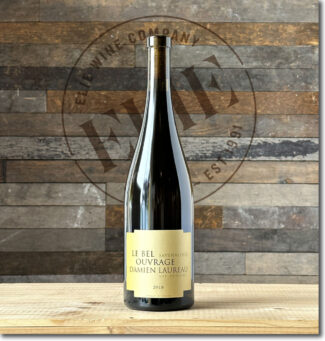 Damien Laureau ‘Le Bel Ouvrage”, 2018 Savennières ($58)
Damien Laureau ‘Le Bel Ouvrage”, 2018 Savennières ($58)
Bel Ouvrage is a firm, long-lived wine from schist soils from Laureau’s five acre holding in Les Petites-Coulées (located close to the western edge of Roche-aux-Moines) as well as a three acre parcel in the Chambourcier lieu-dit. The wine is barrel fermented and aged for a year before being racked into vat to rest on lees for another 6 months. Only the ‘cœur de cuvée’ (the heart of the pressings) is used in ‘Le Bel Ouvrage’, to produce what Laureau considers ‘the purest expression from the best soils’. This produces a wine of substance built to age and develop over many years. The wine shows richly spiced white peach wreathed in a light, clean smokiness.
*click on image for more info
VdF Loire-Anjou
The concept of VDF wines was strikingly innovative at the time it was introduced (2010), allowing vintners to blend wines from different regions and new combinations of grape varieties. It represented a fundamental shift for a country so tied to geographic classification for its wines, but has become one of the country’s biggest selling wine designations.
Terre de l’Élu
When Charlotte and Thomas Carsin purchased Clos de l’Élu in 2008, they may have been new to winemaking, but they had plenty of industry street cred. Thomas had been a wine consultant and Charlotte worked in communication and management. They fell in love with each other, then with the property, situated on some of the most remarkable terroirs in Layon; they began to farm organically, the second most important change they brought to the estate. The first was the name change: As Charlotte explains it, “The word ‘Clos’ is reserved for appellation wines only, and we felt straightjacketed by the rules we’d otherwise have to follow. Terre de l’Élu means ‘Land of the Chosen’.”
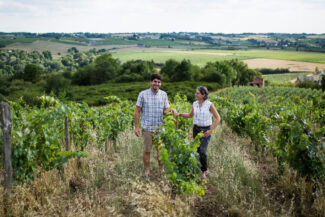
Thomas and Charlotte Carsin, Terre de l’Élu
Terre de l’Élu is located in Saint-Aubin de Luigné with fifty acres spread over 30 different plots scattered from Chaume (famous for its sweet style of botrytized Chenin) to Chaudefons-sur-Layon near the confluence of the Layon and Loire. In this warmer, drier climate, red varieties are widely cultivated alongside the traditional Chenin, all planted on the black slate soils of the western portion of Anjou.
Thomas discusses the difficult decision to withdraw the estate from the AOP of Anjou: “After years of having wines being rejected by the appellation and the associated costs and delays this bureaucratic nightmare entailed, we opted to label ourselves Vin de France. The irony is that these wines are all from the same vineyards and made with even greater care vintage after vintage.”
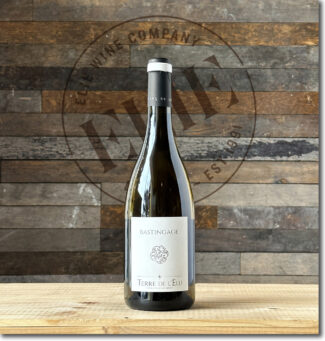 Terre de l’Élu ‘Bastingage’, 2020 VdF Loire-Anjou ($33)
Terre de l’Élu ‘Bastingage’, 2020 VdF Loire-Anjou ($33)
A cuvée of 25-year-old Chenin vines grown shale and sandstone. Grapes are harvested by hand with a strict selection process in the vineyard that requires several passes to ensure that only ripe and healthy fruit is sent to the cellar. There it sees traditional fermentation on indigenous yeast and aging in barrels, followed by a few months in vat before bottling. The wine has a buttery complexity, showing candied lemon behind the type of pronounced minerality typical of wines with roots in shale terroirs.
*click on image for more info
Saumur A.O.P
Saumur has been a major focal point for the commercial wine trade since the 12th century, when (under Henry IV) it was the Huguenot capital. As an appellation, its terroir is rich in Loire’s characteristic calcareous rock, much of which was quarried over the centuries, leaving ideal cellars for aging Saumur wines. The hyphenated Saumur-Champigny is reserved for the 8 communes closest to the city of Saumur, and is restricted to around 3,700 acres, generally hilltop vineyards buffered against the west winds.
Manoir de la Tête Rouge
Intense, driven and passionate, Guillaume Reynouard is the fox in charge of the chicken coop—as well as being a winemaker, he is president of the Syndicat des Vins Saumur and has a particular enmity for growers who rip out Pineau d’Aunis in favor of easier-to-grow varieties.
Taking charge of Domaine Manoir de la Tête Rouge in 1995, Guillaume soon converted to organics and was certified Biodynamic in 2010. The estate enjoys remarkably productive clay/ limestone terroir and he takes pride in ‘living vineyards’ where the soil is worked by hand to ensure that roots go deep and grass grows between rows to promote insect and other plant life; synthetic chemicals are prohibited. In the cellar, grapes are fully destemmed, indigenous yeasts are preferred, with no additions and very minimal sulfur use.
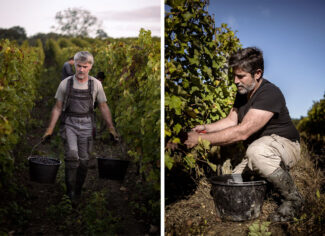
Guillaume Reynouard, Manoir de la Tête Rouge
According to Reynouard, “Responsible agriculture is a way of life and of thinking. When growing grapes, I aspire to act sensibly for the planet—a state of mind that develops naturally from a respectful relationship with nature. Knowing how to adapt to a changing environment requires constant questioning while the planting of forgotten varieties such as Pineau d’Aunis, the incorporation of trees into the cultivation of the vine (agroforestry) and the gradual abandonment of ‘modern’ oenology are avenues that I have followed for more than 20 years.”
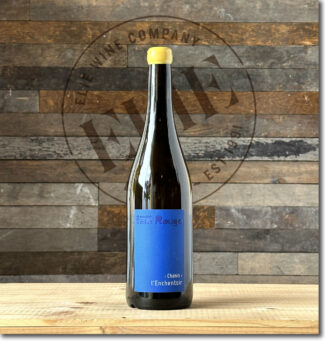 Manoir de la Tête Rouge ‘l’Enchentoir’, 2018 Saumur ‘natural’ ($47)
Manoir de la Tête Rouge ‘l’Enchentoir’, 2018 Saumur ‘natural’ ($47)
100% Chenin fermented spontaneously in new oak and bottled with low sulfites; less that 30g/l. Unfined and light filtered, the wine shows notes of white flowers and quince. Bone dry at less than 1g/l residual sugar, it makes an ideal ‘Saumurtime’ companion to grilled fish.
*click on image for more info
VdF Loire-Saumur
Freed from some of Saumur’s more restrictive rules, this VdF designation allows the creativity that is part of the spirit of Loire winemakers to experiment and innovate.
Château de Fosse-Sèche
If a single concept can describe the most profound change that has seized modern European winemaking, it is biodynamics—techniques that their forebears may have practiced by necessity without naming it, but which today is a nod to the cosmic continuum of which agriculture is only a part. Nowhere is this visionary approach more conspicuous that at Château de Fosse-Sèche, where twin brothers Guillaume and Adrien Pire (who grew up in Madagascar) bring with them not only degrees in agronomy and viticulture, but a deep respect for the wild land of their youth. Along with their wives Julie and Cécile, they have instilled Fosse-Sèche’s 800 year history with an abiding belief in a holistic remake of all phases of winemaking.
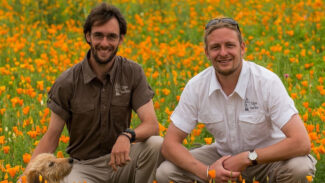
Adrien and Guillaume Pire, Château de Fosse-Sèche
Like an iron-red ruby amid the seafoam of limestone, the soils of Fosse-Sèche are rather unique in the Loire—a fact that has been recognized since the 13th century, when Benedictine monks first planted vines there. Move the clocks ahead to 1998, when the Keller-Pire family took over the estate, enraptured by the beauty of the surroundings and its exceptional terroir, composed of iron oxide and flinty silex just beneath the topsoil. Two-thirds of the Fosse-Sèche property is a natural reserve, with a bird sanctuary, acres of honey flowers, goats and thriving wetlands; of the hundred eleven acres of property, only 37 are used for vines. The single parcel is planted to Cabernet Franc (70%) and Chenin (30%).
Hélène Berteau, a beekeeper, also tends hives on the estate and benefits directly from everything that is done for the ecosystem. Guillaume Pire says, “We maintain between 2 and 5.5 hectares of pollen fallow. The logic of this mixture: bee plants attract pollinating insects and legumes fix nitrogen from the air. These plants loosen and aerate the soil, attract auxiliary insects (ladybugs, butterflies, etc.) and release seeds for birds. The deficiency of pollen and nectar is an important factor in the gradual extinction of populations of bees and other pollinating insects. These flowers are also shelters and potential sources of food for wildlife thanks to this richness in insects.”
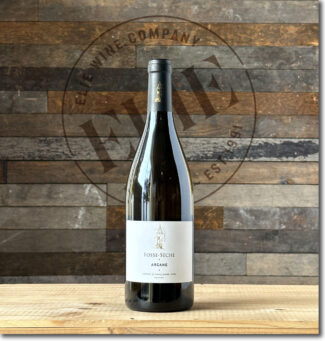 Château de Fosse-Sèche ‘Arcane’, 2020 VdF Loire-Saumur ‘natural’ ($45)
Château de Fosse-Sèche ‘Arcane’, 2020 VdF Loire-Saumur ‘natural’ ($45)
Most Saumur vineyards are grown on a porous yellow limestone known as tuffeau. However, Fosse-Sèche’s biodynamic Chenin vines are planted on a distinctive Jurassic-era flint plateau with gravel and clay. The unique soils and the curved aspect of the vineyards allow for the fresh breeze to cool the vines rooted in heat-absorbing flint soils. The wine displays this bright ripeness; the nose features subtle flavors of honey, pineapple, green apple and pear, leading to a long finish replete with salinity and minerality.
*click on image for more info
Touraine
Touraine’s 13,000 acres follow the Loire river for about sixty miles from Blois in the east to Chinon and Bourgueil in the west; beyond, the river continues into the adjacent Anjou district. Wines made under the regional appellation may be white, red, rosé or sparkling. Whites account for 59 percent of production, reds for 22, rosé for eight and sparkling 11 percent. The whites are most commonly based on Sauvignon Blanc, which accounts for 43 % of all Touraine plantings. Chenin comes a distant second at 7%. The latter is collected almost exclusively in the subregion Montlouis-sur-Loire.
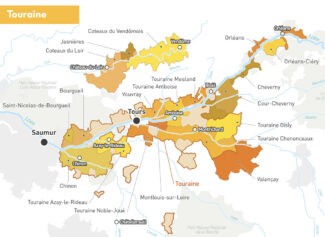
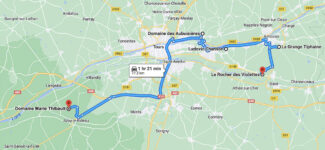
Montlouis-sur-Loire A.O.P
The Montlouis reputation is often overshadowed by Vouvray, just to the north on the other side of the Loire. In fact, until the creation of the Montlouis appellation in 1938, the commune’s wines were labeled and sold as Vouvray.
The thousand-acre appellation includes fifty wine producers in three communes along with a production and marketing co-operative with 15 members. It is bordered by the Loire to the north, the Cher to the south and the forest of Amboise to the east. It is situated in the Indre-et-Loire department of the region Centre-Val de Loire and contains soils that are clay and flint–based soils, with vine roots entering a lower layer of limestone; such soils hold moisture well, even in dry years.
The appellation is planted exclusively to Chenin and produces wine capable of improving for a decade or more. This is because Chenin’s naturally high acidity acts as a preservative which protects the wine from breaking down as it ages. Another plus is Chenin’s intense aromatic composition, marked by notes of acacia blossom, quince and green apples in youth, then honeysuckle, quince and lanolin over time.
Le Rocher des Violettes
After studying winemaking in Chablis and Beaune and earning degrees in viticulture and oenology, Xavier Weisskopf found work at Gigondas producer Château de Saint Cosme, and under taskmaster Louis Barruol, rose quickly to the rank of Chef du Cave. He was responsible for four vintages before a passion for Chenin lured him to Montlouis, where was fortunate to find 22 acres of old vine Chenin. He immediately converted the farming of all his vines to certified organics, with the aim to allow these precious old vines to speak without a smokescreen.
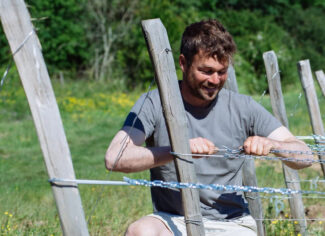
Xavier Weisskopf, Le Rocher des Violette
“My goal is to protect this incredible legacy of these old vines,” he says candidly. “They are capable of making wines of clarity, focus and laser precision.”
Since obtaining organic certification in 2012, Weisskopf has embarked on an acquisition project, purchasing small plots divided between the appellations of Montlouis and Touraine. Amazingly, contained within his (now) 37 acres are Côt vines that are around 130 years old.
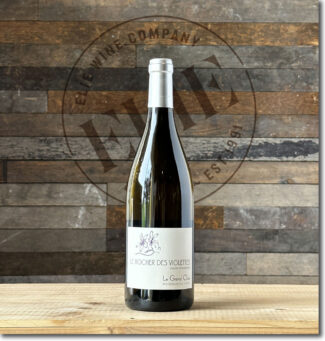 Le Rocher des Violettes ‘Le Grand Clos’, 2020 Montlouis-sur-Loire ($33)
Le Rocher des Violettes ‘Le Grand Clos’, 2020 Montlouis-sur-Loire ($33)
100% Chenin Massale selection from three Montlouis lieux-dits, Les Borderies, Le Grand Clos and Bel Air. These parcels contain the estate’s oldest Chenin vines, more than ninety years old. They are high-density-planted on south-facing slopes where the soils are rich clay and silex over chalk. Having been fermented and raised in 500-liter barrels for 10 months, the subtle wood notes shows up as almond pastry. The wine itself is bright with stone fruits like apricot and peach, while the taut quality is evidence that these qualities will mature without losing freshness.
*click on image for more info
La Grange Tiphaine
Damien Delecheneau represents the fifth generation of his family to farm this lieu-dit on the upper part of the gorgeous Renaissance city of Amboise, just east of Montlouis-sur-Loire. Although he took the property over when his father retired in 2002, it wasn’t until 2007 that Damien decided to dedicate the property solely to wine production as opposed to the cereal grains the farm also produced. It took a global recession and some soul searching before Damien concluded that his forefathers had been right to diversify. “The overspecialization of a farm towards one crop is unproductive, from both a financial and environmental point of view.” He explains. And so, he began a side business of négoce, and helped growers around him to convert to organic farming by buying their fruits. In addition, he dedicated some fields for horses, pasture, hay production, with the idea to maybe come back one day to farm other crops.
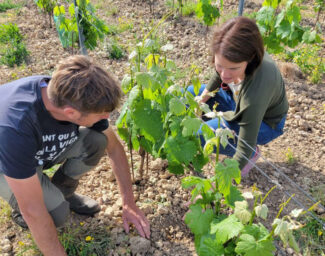
Damien and Coralie Delecheneau, La Grange Tiphaine
With his Alsace-born wife Coralie handling sales, Damien concentrates on 42 acres of vineyard split almost evenly between Amboise and Montlouis.
“Both our minds meet in the cellar,” says Coralie. “where we have invested in finding the right tools for the quality of wine we insist on producing, and with the minimum amount of sulfur. All our domain cuvées are made with the same level of perfectionism; hand-harvested, hand-sorted in the vineyard then again at the cellar, pressed with two top-of-the-line pneumatic presses fed by gravity. The whites are pressed whole-cluster directly, cooled and settled overnight, then fermented either in cement tanks, eggs or barrels.”
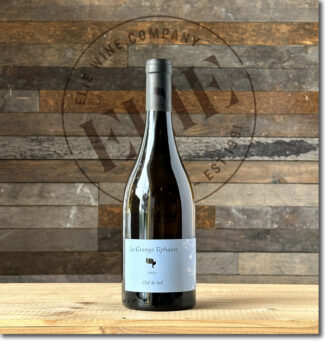 La Grange Tiphaine ‘Clef de Sol’, 2021 Montlouis-sur-Loire Sec ($37)
La Grange Tiphaine ‘Clef de Sol’, 2021 Montlouis-sur-Loire Sec ($37)
Clef de Sol, meaning ‘treble clef’ is a tribute to the music of both Damien (clarinetist) and Coralie (choirist). The wine is a blend of southern-exposed plots located in Montlouis grown on clay and flint over tuffeau where the vines are mostly 80 years old. The Delecheneaus consider this a benchmark wine for Montlouis, referring to it as ‘Savennières meets Brézé’, with specific smoky notes coming from the Montlouis flint. It displays a floral side, lemon-verbena and linden, quinine, peach pit and salt. The oak is very well balanced, with just a hint of white tobacco.
*click on image for more info
Ludovic Chanson
Chanson’ is an ideal name for this beautiful fifteen acre estate: It means ‘song’. It’s also the surname of the owner, Ludovic Chanson, who took over from retiring winemaker Alex Mathur in 2009. The vineyards lie on the plateau near the village of Husseau, a five-minute drive outside of Montlouis. Most of Chanson’s property is planted to Chenin; the rest to Chardonnay and Sauvignon Blanc. Soils are clay heavy with a deep limestone base and many of the parcels are littered with silex and flint and the average vine is about 40 years old.
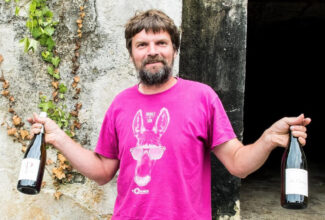
Ludovic Chanson
Chanson trusts his processes and focuses on farming; the estate was converted to organic before Ludovic took over, and he has since achieved certification. Harvesting is done by hand in small baskets, with one pass for the Sauvignon Blanc and Chardonnay and multiple passes for the Chenin, depending on the cuvée for which the grapes are being picked.
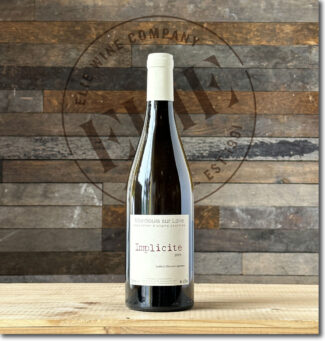 Ludovic Chanson ‘Implicite’, 2019 Montlouis-sur-Loire Sec ‘natural’ ($49)
Ludovic Chanson ‘Implicite’, 2019 Montlouis-sur-Loire Sec ‘natural’ ($49)
Chenin from the final pass through his oldest vines; according to Chanson, these are ‘the most beautiful grapes you can pick.’ After spontaneous fermentation in neutral oak, the wine undergoes a long élevage, resulting in a luscious blend of stone fruit, honeycomb, almond pastry and clean candied apricot.
*click on image for more info
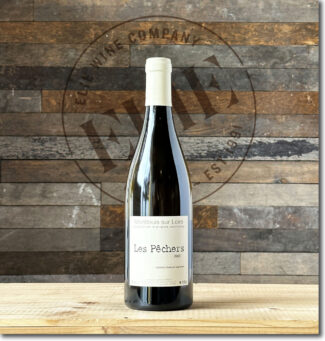 Ludovic Chanson ‘Les Pêchers’, 2020 Montlouis-sur-Loire Sec-Tendre ‘natural’ ($37)
Ludovic Chanson ‘Les Pêchers’, 2020 Montlouis-sur-Loire Sec-Tendre ‘natural’ ($37)
Chanson noticed some botrytis on the grapes in this vintage; it adds layers of honeyed depth to the fruit. 100% Chenin grown in clay, deep limestone, some silex and flint, the grapes undergo direct pressing, then are transferred to barrels with 10 months maturation in 400-liter barrels. No fining, but the juice is given a light diatomaceous earth filtration and bottled with a scant whisper of sulfur, allowing the term ‘natural.’ The nose shows roasted almonds and candied pears, the rich, sweet tones of the palate echo these and the ample acids keep the package in balance.
*click on image for more info
Vouvray A.O.P
“Vouvray is Chenin, and to a certain extent, Chenin is Vouvray” –Jancis Robinson.
Although our recent discoveries might test the ‘extent’, it is fair to say that the AOP Vouvray is the world’s most recognized Chenin, even though those two words do not appear on the label. Certainly the most famous and most respected appellation in Touraine, the title covers Chenin wines of styles ranging from dry to sweet, from still to sparkling, from eight villages around the medieval town of Vouvray on the northern banks of the Loire river. 5,436 acres are currently under vine. Ironically, perhaps, the region’s sole production grape is not even called Chenin, but Pineau de la Loire.
In any case, Vouvray was one of France’s earliest official appellation titles, created just after the INAO was founded in 1936 although the region has produced quality white wine since the Middle Ages. The critical element of the local terroir is tuffeau, the calcareous rock found in pockets throughout the central Loire, most notably in Saumur and here in Vouvray. Tuffeau is a soft, porous limestone that exist as chalkier, firmer tuffeau blanc and softer, sandier tuffeau jaune. Due to its porosity, tuffeau strikes an excellent balance of drainage and water retention, saving vines from both waterlogging and drought. Local topography creates sufficient differences in the maritime/continental climate to create pockets where exceptionally age-worthy wines find a home.
Domaine des Aubuisières
To master the art of ‘Vouvray’, one must perfectly integrate the minerality of the soil with the fruit acids of the grape. Bernard Fouquet, a quiet-spoken man, is regarded in France and the international press as a winemaker who has excelled at this, vintage after vintage.
Having burst onto the Vouvray scene in 1989, Fouquet bottled a number of high-quality sweet wines which took advantage of everything that exalted vintage offered. He followed up with the brilliant 1990 vintage and since then, various cuvées from the 1995, 1996 and 1997 vintages remain brilliant after more than twenty years of age.
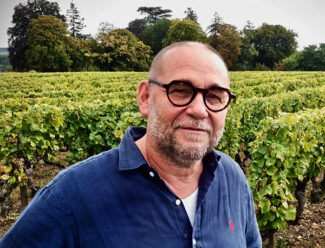
Bernard Fouquet, Domaine des Aubuisières
Bernard has recently handed over the running of the domain to Charles Lesaffre, formerly the commercial director of Vignobles Feray (which includes Château Moncontour). The transition was accelerated during the Covid-19 pandemic, Charles essentially taking over at the time of the 2020 harvest, with a formal handover in 2021.
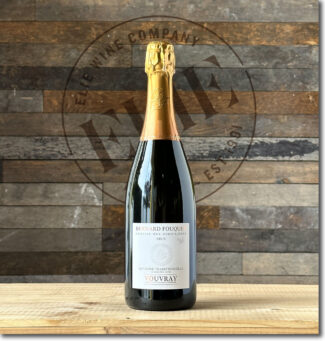 Domaine des Aubuisières, 2019 Vouvray Sparkling Brut ($23)
Domaine des Aubuisières, 2019 Vouvray Sparkling Brut ($23)
100% Chenin, made when the winemaking was still in the hands of Fouquet. A precise and moderately intense sparkling wine with aromas of toast, apple and beeswax behind mineral-tinged smoke and driven through by bright acidity. Superb balance, length and structure.
*click on image for more info
VdF Loire-Touraine-(Azay-le-Rideau)
Evidence exists that winegrowing in Touraine began in Azay le Rideau during the Gallo Roman Empire. It is also the site of the magnificent Château d’Azay, whose royal patrons gave preference to local terroir wines at their tables. Evenly split between rosé made of Grolleau and bright, Chenins, the appellation stretches over eight communes on the banks of the Indre and the Loire rivers close to where the rivers meet. With a surface area under 150 acres, the subsoils are a blend of clay, limestone and Aeolian sand. Climate tends to be mild enough that, in particularly warm years, favors the production of botrytized wines.
Domaine Marie Thibault
“I grew up in the Loire Valley, but unlike many vignerons working in the Loire, I did not come from a winemaking family,” says Marie Thibault, adding, “But also unlike many of them, I have degrees in both biology and oenology.”
Marie Thibault began making wine in the early 2000s, working for a time with François Chidaine in Montlouis, where she fell in love with Chenin Blanc. In 2011, she founded her own nine acre estate on a single windy slope in Azay-le-Rideau, a lesser known commune of Touraine. She immediately converted to organics and has been certified with Ecocert since 2014. Among the natural elements in her vineyards is the flock of two dozen ewes that graze between the vine rows during the autumn; every ten days, they are penned inside a new hectare to keep the soil naturally fertile and the grass clipped.
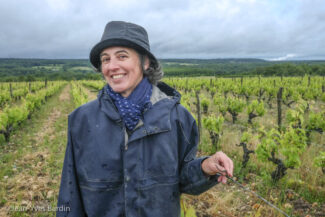
Marie Thibault, Domaine Marie Thibault © Jean-Yves Bardin
“My vineyard is small, but the soils are extremely varied and as such, so are the grapes I grow. I work with Côt (Malbec), and have a special love for Gamay, Grolleau, Chenin Blanc and Sauvignon Blanc. Most of my vines are at least 50 years old. I compensate for small production by purchasing from organic estates nearby, especially those owned by my family.”
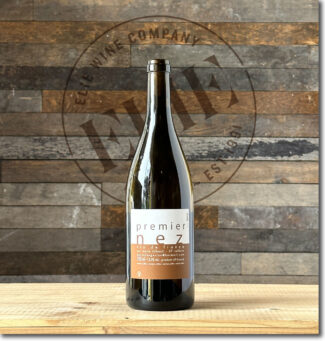 Domaine Marie Thibault ‘Premier Nez’, 2019 VdF Loire-Touraine-Azay-le-Rideau ‘natural’ ($42)
Domaine Marie Thibault ‘Premier Nez’, 2019 VdF Loire-Touraine-Azay-le-Rideau ‘natural’ ($42)
From Marie’s contiguous parcel on a windy slope that is drier than the other vineyards of Azay-le-Rideau. Terroir here is composed of Chenin-loving, white clay and limestone. This wine, from 40-year-old vines, sees 14-15 months of élevage in demi-muid and barriques to produce a spicy wine loaded with dried citrus peel, aniseed, pine resin, walnut and yellow pear.
- - -
Posted on 2023.07.13 in Touraine, Anjou, Vouvray, Montlouis-sur-Loire, France, Wine-Aid Packages, Loire
Featured Wines
- Notebook: A’Boudt Town
- Saturday Sips Wines
- Saturday Sips Review Club
- The Champagne Society
- Wine-Aid Packages
Wine Regions
Grape Varieties
Aglianico, Albarino, Albarín Blanco, Albarín Tinto, Albillo, Aleatico, Arbanne, Aubun, Barbarossa, barbera, Beaune, Biancu Gentile, bourboulenc, Cabernet Franc, Cabernet Sauvignon, Caino, Caladoc, Calvi, Carcajolu-Neru, Carignan, Chablis, Chardonnay, Chasselas, Clairette, Corvina, Cot, Counoise, Erbamat, Ferrol, Fiano, Frappato, Friulano, Fromenteau, Fumin, Garnacha, Gewurztraminer, Godello, Graciano, Grenache, Grolleau, Groppello, Juan Garcia, Lambrusco, Loureira, Macabeo, Macabou, Malvasia, Malvasia Nera, Marsanne, Marselan, Marzemino, Melon de Bourgogne, Merlot, Mondeuse, Montanaccia, Montepulciano, Morescola, Morescono, Moscatell, Muscadelle, Muscat, Natural, Nero d'Avola, Parellada, Patrimonio, Petit Meslier, Petit Verdot, Pineau d'Aunis, Pinot Auxerrois, Pinot Blanc, Pinot Gris, Pinot Meunier, Pinot Noir, Poulsard, Prieto Picudo, Rondinella, Rousanne, Roussanne, Sangiovese, Sauvignon Blanc, Savignin, Semillon, Souson, Sparkling, Sumoll, Sylvaner, Syrah, Tannat, Tempranillo, Trebbiano, Trebbiano Valtenesi, Treixadura, Trousseau, Ugni Blanc, vaccarèse, Verdicchio, Vermentino, Viognier, Viura, Xarel-loWines & Events by Date
- April 2024
- March 2024
- February 2024
- January 2024
- December 2023
- November 2023
- October 2023
- September 2023
- August 2023
- July 2023
- June 2023
- May 2023
- April 2023
- March 2023
- February 2023
- January 2023
- December 2022
- November 2022
- October 2022
- September 2022
- August 2022
- July 2022
- June 2022
- May 2022
- April 2022
- March 2022
- February 2022
- January 2022
- December 2021
- November 2021
- October 2021
- September 2021
- August 2021
- July 2021
- June 2021
- May 2021
- April 2021
- March 2021
- February 2021
- January 2021
- December 2020
- November 2020
- October 2020
- September 2020
- August 2020
- July 2020
- June 2020
- May 2020
- April 2020
- March 2020
- February 2020
- January 2020
- December 2019
- November 2019
- October 2019
- September 2019
- August 2019
- July 2019
- June 2019
- May 2019
- April 2019
- March 2019
- February 2019
- January 2019
- December 2018
- November 2018
- October 2018
- September 2018
- August 2018
- July 2018
- June 2018
- May 2018
- April 2018
- March 2018
- February 2018
- January 2018
- December 2017
- November 2017
- October 2017
- September 2017
- August 2017
- July 2017
- June 2017
- May 2017
- April 2017
- March 2017
- February 2017
- January 2017
- December 2016
- November 2016
- October 2016
- September 2016
- August 2016
- July 2016
- June 2016
- May 2016
- April 2016
- March 2016
- February 2016
- January 2016
- December 2015
- November 2015
- October 2015
- September 2015
- August 2015
- July 2015
- June 2015
- May 2015
- April 2015
- March 2015
- February 2015
- January 2015
- December 2014
- November 2014
- October 2014
- September 2014
- August 2014
- July 2014
- June 2014
- April 2014
- March 2014
- February 2014
- January 2014
- December 2013
- November 2013
- October 2013
- September 2013
- August 2013
- July 2013
- June 2013
- May 2013
- April 2013
- March 2013
- February 2013
- January 2013
- December 2012
- November 2012
- October 2012
- February 2004
Search



